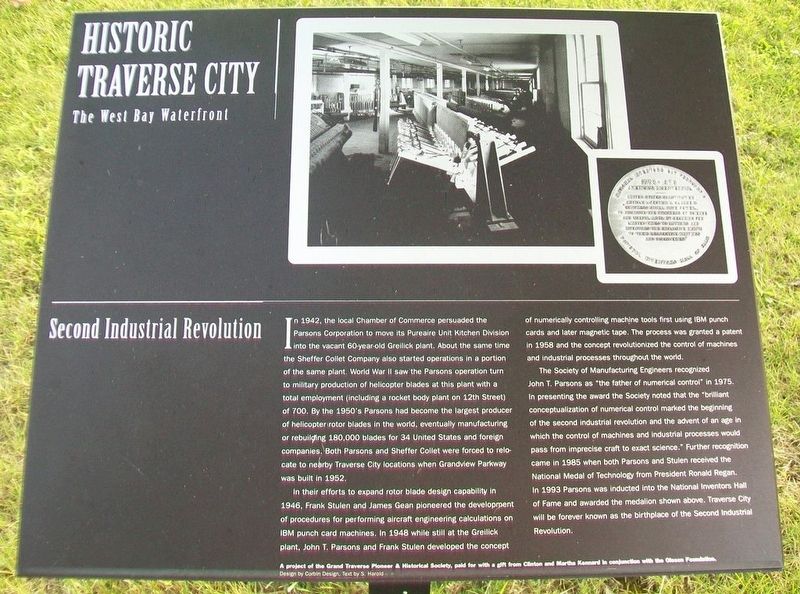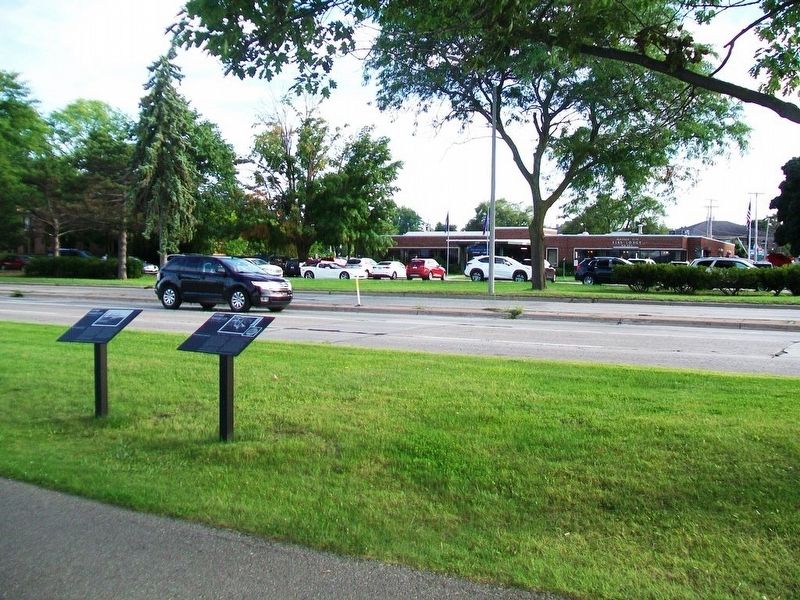Traverse City in Grand Traverse County, Michigan — The American Midwest (Great Lakes)
Second Industrial Revolution
Historic Traverse City
— The West Bay Waterfront —
In 1942, the local Chamber of Commerce persuaded the Parsons Corporation to move its Pureaire Unit Kitchen Division into the vacant 60-year-old Greilick plant. About the same time the Sheffer Collet Company also started operations in a portion of the same plant. World War II saw the Parsons operation turn to military production of helicopter blades at this plant with a total employment (including a rocket body plant on 12th Street) of 700. By the 1950's Parsons had become the largest producer of helicopter rotor blades in the world, eventually manufacturing or rebuilding 180,000 blades for 34 United States and foreign companies. Both Parsons and Sheffer Collet were forced to relocate to nearby Traverse City locations when Grandview Parkway was built in 1952.
In their efforts to expand rotor blade design capability in 1946, Frank Stulen and James Gean pioneered the development of procedures for performing aircraft engineering calculations on IBM punch card machines. In 1948 while still at the Greilick plant, John T. Parsons and Frank Stulen developed the concept of numerically controlling machine tools first using IBM punch cards and later magnetic tape. The process was granted a patent in 1958 and the concept revolutionized the control of machines and industrial processes throughout the world.
The Society of Manufacturing
Engineers recognized John T. Parsons as "the father of numerical control" in 1975. In presenting the award the Society noted that the "brilliant conceptualization of numerical control marked the beginning of the second industrial revolution and the advent of an age in which the control of machines and industrial processes would pass from imprecise craft to exact science." Further recognition came in 1985 when both Parsons and Stulen received the National Medal of Technology from President Ronald Regan. In 1993 Parsons was inducted into the National Inventors Hall of Fame and awarded the medalion shown above. Traverse City will be forever known as the birthplace of the Second Industrial Revolution.Erected by Grand Traverse Pioneer & Historical Society, Clinton and Martha Kennard, and the Oleson Foundation.
Topics and series. This historical marker is listed in these topic lists: Industry & Commerce • Science & Medicine. In addition, it is included in the Former U.S. Presidents: #40 Ronald Reagan series list. A significant historical year for this entry is 1942.
Location. 44° 46.134′ N, 85° 38.024′ W. Marker is in Traverse City, Michigan, in Grand Traverse County. Marker is at the intersection of Grandview Parkway (U.S. 31) and Division Street (U.S. 31), on the right when traveling west
on Grandview Parkway. Touch for map. Marker is in this post office area: Traverse City MI 49684, United States of America. Touch for directions.
Other nearby markers. At least 8 other markers are within walking distance of this marker. The J.E. Greilick Factory (here, next to this marker); Korean War Memorial (about 800 feet away, measured in a direct line); Friends Meetinghouse (approx. half a mile away); Hannah and Lay Mercantile Building (approx. 0.6 miles away); City Opera House (approx. 0.6 miles away); Ladies Library Association / Ladies Library Building (approx. ¾ mile away); Central United Methodist Church (approx. 0.8 miles away); Novotny's Saloon (approx. 0.8 miles away). Touch for a list and map of all markers in Traverse City.
Also see . . .
1. John T. Parsons: The Father of Numerical Control. Institute of Electrical and Electronics Engineers website entry (Submitted on September 27, 2016, by William Fischer, Jr. of Scranton, Pennsylvania.)
2. John T. Parsons: 2000 National Medal Winner. The White House National Millennium Time Capsule website entry (Submitted on September 27, 2016, by William Fischer, Jr. of Scranton, Pennsylvania.)
3. Frank L. Stulin. Wikipedia entry (Submitted on January 30, 2022, by Larry Gertner of New York, New York.)
Credits. This page was last revised on January 30, 2022. It was originally submitted on September 26, 2016, by William Fischer, Jr. of Scranton, Pennsylvania. This page has been viewed 573 times since then and 54 times this year. Photos: 1, 2. submitted on September 27, 2016, by William Fischer, Jr. of Scranton, Pennsylvania.

